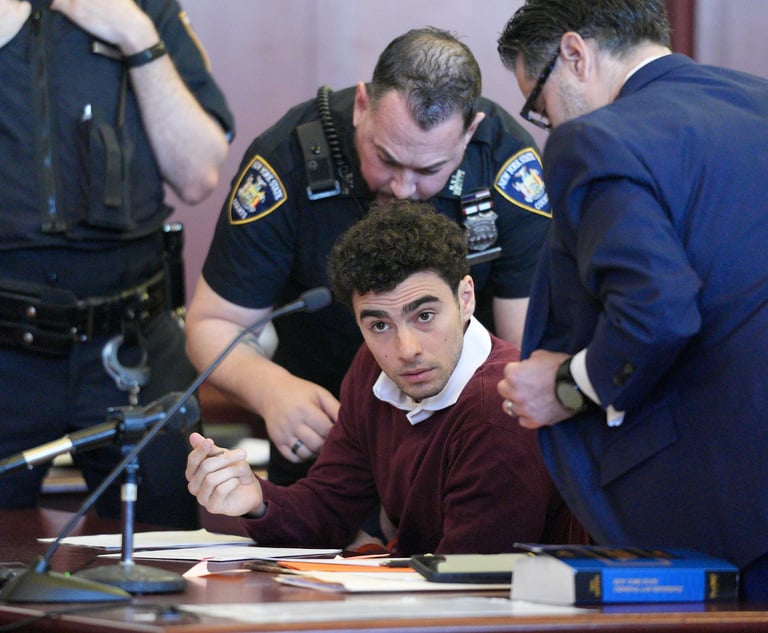What Does it Mean to be a Lawyer? These 5 Techniques Show the Way
Here's my resume: 36 years a practicing lawyer; 2.5 years as a full-time law professor. I learned to think like a lawyer; now I teach others how.…
February 01, 2018 at 12:00 AM
5 minute read
 Michael P. Maslanka.
Michael P. Maslanka.
Here's my resume: 36 years a practicing lawyer; 2.5 years as a full-time law professor. I learned to think like a lawyer; now I teach others how. So, here are some techniques to do just that (portable to new oath takers, as well).
Technique No. 1: Know the reason for a rule, not just the rule
A student in my Professional Responsibility class (colloquially called “PR”) tells me: “I am learning a lot in the class, but why are you so philosophical about the “why's” for a rule?” Fair question. I remain grateful for it. So now I tell my classes, “You will be in thousands of firefights in your career. The lawyer who knows the rule and the reason for the rule will always have the advantage over the lawyer who knows the rule only.”
Example: Sexual harassment lawsuit; plaintiff's deposition is being taken; dispute over a critical conversation. Defense lawyer yanks several cassettes out of her briefcase, lines them up like toy soldiers in front of her, each with a label identifying it as a tape recording of the conversation. Cassettes are empty. Deceit? Yes. But why is this not merely zealous advocacy? Because the tactic frustrates the search for the truth, suggests that the lawyer has evidence that does not exist and creates an uneven playing field. (True case that resulted in a six-month suspension.)
I apply the same mindset in teaching First Amendment. Each class starts with the same question as to each case we discuss: “What problem was the Supreme Court trying to resolve in this case?” Embrace the “why,” not merely the “what,” “who” and “when.”
Technique No. 2: Words matter and they matter a lot
Here is an exercise I go through with students. They read a Model Rule of Professional Responsibility. I ask: “What's the most important word in the rule?” Once it's identified, I ask: “What other words could the drafters have used? Why did they pick the word that they did?”
Example: Lawyers must keep “confidential” what clients tell them that “relate” to representation. If the class is popping on all cylinders, then the students come to understand that “relate” is more expansive than “deal” or “involved” by embracing the more expansive word then more communication, not less, is protected from disclosure. Words used are used for a purpose. That's the take-away for students.
Technique No. 3: Show, don't tell
The very best lawyers live this maxim. Illustrations abound. Watch the movie “The Rainmaker” and see how the plaintiff's lawyer skillfully holds up two pieces of paper: one with claims made and the other with claims denied. Devastating. In class, I ask students to flow chart out a rule or a case; if X happens then go to Y; if X doesn't happen then go to Z. We have wonderful docucams and the student comes to the front of the class and walk me and their colleagues through their charts. Here's the bonus room: The students begin to grasp how to think in terms of threshold questions.
Technique No. 4: Be vivid
This technique is a cousin to the previous one. How to teach it? By example: “If it doesn't fit, you must acquit.” A cheap tag line, inconsistent with the lofty study of the law? Hey, it worked. Students need to know we are in the business of persuading, which is the business of making your point a vivid and thus memorable one.
Back to PR. On day one, I play this scene from the movie “Scent of a Woman”: Al Pacino as Colonel Frank Slade defends Charlie before a board of inquiry. He contrasts Charlie's integrity to his lack of it. I paraphrase: “I have come to the cross roads in my life. And each time, I knew the right path to take, but I never took it and do you know why? Because it was too damn hard.” And so, when we staircase law when a lawyer errs in judgment, guess what we go back to?
Technique No. 5: Make 'because' your favorite word
In a world choked with conclusions and undisciplined thinking, it becomes the duty of lawyers to provide reasoning and clarity. In class, a student will give an answer or offer an opinion, and, if unsupported, I raise my right hand, place thumb and index finger in proximity, draw an imaginary line through the air and say “because.”
We can teach students to think like lawyers. But that's just scaffolding, isn't it? We can only urge them to be lawyers. And what does it mean to be a lawyer? Lawyer/novelist William Lashner sums it up in “Past Due” when his protagonist, Victor Carl, sums it up while ruminating on a client: “He was a client. It means something to be a client. It means he gets my loyalty, whether he deserves it or not. It means he gets my absolute best for the price of an hourly fee. It means in a world where every person has turned against him, there is one person who will fight by his side for as long as there is a battle to be fought.”
And if that isn't the truth, what is?
This content has been archived. It is available through our partners, LexisNexis® and Bloomberg Law.
To view this content, please continue to their sites.
Not a Lexis Subscriber?
Subscribe Now
Not a Bloomberg Law Subscriber?
Subscribe Now
NOT FOR REPRINT
© 2025 ALM Global, LLC, All Rights Reserved. Request academic re-use from www.copyright.com. All other uses, submit a request to [email protected]. For more information visit Asset & Logo Licensing.
You Might Like
View All

Nondisparagement Clauses in Divorce: Balancing Family Harmony and Free Speech
6 minute read

Trending Stories
Who Got The Work
J. Brugh Lower of Gibbons has entered an appearance for industrial equipment supplier Devco Corporation in a pending trademark infringement lawsuit. The suit, accusing the defendant of selling knock-off Graco products, was filed Dec. 18 in New Jersey District Court by Rivkin Radler on behalf of Graco Inc. and Graco Minnesota. The case, assigned to U.S. District Judge Zahid N. Quraishi, is 3:24-cv-11294, Graco Inc. et al v. Devco Corporation.
Who Got The Work
Rebecca Maller-Stein and Kent A. Yalowitz of Arnold & Porter Kaye Scholer have entered their appearances for Hanaco Venture Capital and its executives, Lior Prosor and David Frankel, in a pending securities lawsuit. The action, filed on Dec. 24 in New York Southern District Court by Zell, Aron & Co. on behalf of Goldeneye Advisors, accuses the defendants of negligently and fraudulently managing the plaintiff's $1 million investment. The case, assigned to U.S. District Judge Vernon S. Broderick, is 1:24-cv-09918, Goldeneye Advisors, LLC v. Hanaco Venture Capital, Ltd. et al.
Who Got The Work
Attorneys from A&O Shearman has stepped in as defense counsel for Toronto-Dominion Bank and other defendants in a pending securities class action. The suit, filed Dec. 11 in New York Southern District Court by Bleichmar Fonti & Auld, accuses the defendants of concealing the bank's 'pervasive' deficiencies in regards to its compliance with the Bank Secrecy Act and the quality of its anti-money laundering controls. The case, assigned to U.S. District Judge Arun Subramanian, is 1:24-cv-09445, Gonzalez v. The Toronto-Dominion Bank et al.
Who Got The Work
Crown Castle International, a Pennsylvania company providing shared communications infrastructure, has turned to Luke D. Wolf of Gordon Rees Scully Mansukhani to fend off a pending breach-of-contract lawsuit. The court action, filed Nov. 25 in Michigan Eastern District Court by Hooper Hathaway PC on behalf of The Town Residences LLC, accuses Crown Castle of failing to transfer approximately $30,000 in utility payments from T-Mobile in breach of a roof-top lease and assignment agreement. The case, assigned to U.S. District Judge Susan K. Declercq, is 2:24-cv-13131, The Town Residences LLC v. T-Mobile US, Inc. et al.
Who Got The Work
Wilfred P. Coronato and Daniel M. Schwartz of McCarter & English have stepped in as defense counsel to Electrolux Home Products Inc. in a pending product liability lawsuit. The court action, filed Nov. 26 in New York Eastern District Court by Poulos Lopiccolo PC and Nagel Rice LLP on behalf of David Stern, alleges that the defendant's refrigerators’ drawers and shelving repeatedly break and fall apart within months after purchase. The case, assigned to U.S. District Judge Joan M. Azrack, is 2:24-cv-08204, Stern v. Electrolux Home Products, Inc.
Featured Firms
Law Offices of Gary Martin Hays & Associates, P.C.
(470) 294-1674
Law Offices of Mark E. Salomone
(857) 444-6468
Smith & Hassler
(713) 739-1250






